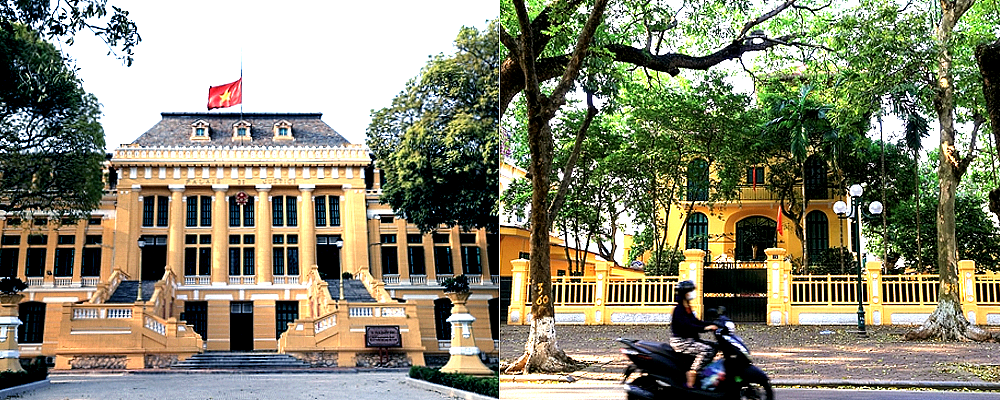
The new paint of a villa dating to the French colonial era at 49 Trần Hưng Đạo Street in downtown Hà Nội has been a burning issue for the public and particularly heritage lovers. People have argued about the striking new colours of the building.
“The renovation is great news for Hà Nội,” Martin Rama, a consultant to the President of the World Bank, who had spent many years living in Hà Nội, told Việt Nam News.
“Not that the building is extraordinary from an architectural point of view, but there are not so many of these villas left in the city, around 1,000 of them. And they are being demolished. They are crumbling. They’re falling apart. They’re being replaced by new buildings, and that’s bad for the visual aspect of Hà Nội.
“An extraordinary mix of different traditions, cultural, architectural, tree-lined streets. Keeping these buildings is very valuable for the city.”
But there has been debate on the bold new colours. Many feel the building no longer fits with the aesthetics of the street.
“People may have a point. We all like the more romantic looks of the villas in yellow tones with the vegetation growing on them,” Rama said.
“But anyway, with the weather of Hà Nội we know what will happen. It will look like a normal Hà Nội building in a matter of years. The debate itself is very good as it shows that people now care about the preservation of the architectural heritage of the city. A few years ago, I would say very few people cared.”
The two-storey villa, a government property on the area of 990sq.m, was almost abandoned for many years. The renovation project was planned in 2016, but it actually started in April 2022 at a cost of VNĐ14.7 billion (US$630,000) by Hoàn Kiếm District authorities and experts from Paris. It is almost complete.
According to architect Emmanuel Cerise, who is responsible for the project, they had very few materials and images of the building to work with.
“It’s courageous and interesting to present an example of this type of restoration with gentle colors and faux bricks,” he said.
“We tend to think that French-era villas have pale colour because those are colors that have been weathered through time and lost their vibrancy. But the truth is that the colors are not pale.”
Historian Dương Trung Quốc showed sympathy for the restorers. He said the experts must have done serious research on the villa’s materials and designs before making any final decisions.
The capital has a huge architectural heritage, besides big villas used as State offices, there are private villas, and even entire streets of villas.
Quốc complained that bad urban management in certain periods had resulted in the disappearance of many French-era buildings.
He also said Hà Nội authorities had paid much attention to this through serious research and surveys as well as policies.
“We have well-used many buildings like today’s Central Library, the Presidential Palace, Albert Sarraut Lyceé, and Government Guest House, and the People’s High Court of Justice,” he said.
Quốc said 49 Trần Hưng Đạo was formerly a private villa with almost no materials or images of it recorded.
According to the Hà Nội City’s Construction Department, there are over 1,200 villas from the French era, of which 367 were managed by the State, 372 others by both individuals and State, and 117 possessed entirely by private individuals.
The buildings have been listed in various groups: 222 in Group 1 that need restoring following the original design; 356 in Group 2 needing to keep the external design; and 638 in Group 3, which can be demolished in case their conditions further deteriorate.

Adaptive restoration
Many experts have proposed adaptive restoration for French villas in Hà Nội.
Architect Trương Ngọc Lân, deputy head of the Architecture and Urban Planning Faculty under the Hà Nội University of Civil Engineering, appreciated the architectural heritage of the French era.
“In terms of the professional architecture factor, buildings by the French built before 1954 have various values in terms of history, society and art,” he said.
“The appearance of French buildings has created a new type of living style. Before, Vietnamese people lived in attached houses built in a rural style. Since the French arrived, they built houses in the Western style, with multi-functions. The French buildings marked the development of Vietnamese society from tradition to modernity.”
Lân emphasized the change of art concepts and the way of thinking about beauty.
“Before we had the traditional style of art, yet the next generations accepted a fresh western stream of art, which has turned out to be an essential part of Vietnamese people’s artistic life,” he said.
Lân also mentioned the values in terms of the technology of French architects who skilfully combined the existing spaces with western design and eastern sloped roofs, local decorative patterns, and various adaptive solutions to the Hà Nội tropical weather.
Lân said the French houses in Hà Nội were a valuable architectural heritage, forming the identity of the city. But he was worried that the restoration of villas in the city had not been carried out properly.
“Many buildings have been possessed by different individuals and organizations who are not fully aware of the heritage’s values,” he said. “Many villas have not been classified yet. Over time, such houses are sold and demolished for other modern buildings.”
Lân said such restorations, like the building on Trần Hưng Đạo Street, had been regularly conducted but due to limited budgets, there were only a few buildings restored this way.
“We should learn the adaptive restoration from well-developed countries where people understand the value of heritage, know the benefits of doing good restoration and are bound by detailed and clarified laws” he said.
“Residents still can exploit the economic effectiveness of the buildings while keeping the core designs.”
Architect Trần Quốc Bảo, from the same faculty, supported this idea.
“We should let residents know that they benefit from restoration like in other countries. They have strict regulations that people living inside heritage buildings who want to upgrade must submit plans to concerned agencies,” he said.
“Most will upgrade the house while keeping the external appearance. They may make some changes like replacing wooden windows with metal frames, but they keep the original form. And the city spares a certain budget to support the renovation while keeping the appearance of historical buildings.”
Lân and Bảo both emphasized that authorities should have proper policies and budget to restore the French villas together with private owners.
“Otherwise, we have to accept the fact that occasionally, French-era buildings may disappear and be replaced by other buildings like the house owned by Dr Trần Duy Hưng, the first mayor of Hà Nội since 1954, in Lý Thái Tổ Street,” Bảo said. “This is a real regret.”
Quốc said if the city found a proper way to renovate old buildings, the old architecture of the city could be restored and the beauty of Hà Nội would be much enhanced.
He mentioned the headquarters of the People’s High Court of Justice, where the central building has been kept and surrounding buildings have been newly built, as well as Hàng Trống Police Station as examples of successful adaptive restoration.
“I think the renovation process is on the right track,” he said.
“This is a positive trend and we should support it. This does not mean one-way support. Citizens have the right to supervise restoration. But they should supervise it based on goodwill and affection. They should do their research and share their knowledge with concerned agencies. This will bring great benefits to the community in our capital.”

ADVERTISEMENT
ADVERTISEMENT








































